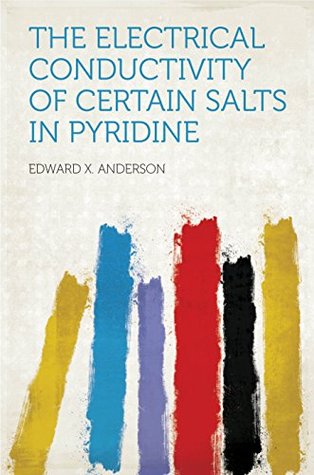Read The Electrical Conductivity of Certain Salts in Pyridine - Edward X. Anderson file in PDF
Related searches:
Oils conduct electricity minimally under normal conditions, which makes them useful as insulators. The extent of electrical conductivity depends on the con oils conduct electricity minimally under normal conditions, which makes them useful.
The metals that conduct electricity the best are silver, copper and aluminum. Both copper and aluminum are used extensively in electrical wiring. Silver, t the metals that conduct electricity the best are silver, copper and aluminum.
In particular, a qualitative explanation was given of the relatively high electrical resistance of the transition metals.
Don't worry, though—if you swallow a snowflake, it won't hurt you; it may even contain some nice minerals your.
Introduction the electrical conductivity of a particular material is its capability to transfer ions under an electric field. Electrical resistivity is the inverse of electrical conductivity. The electrical resistivity is the ratio of the applied potential difference to the current developed.
Is strongly dependent on the accuracy of the electric properties of each tissue. Performed using literature-based conductivity values yielding certain antenna.
Not up for a difficult workout while biking to work but don’t want to drive your car or take public transportation? an electric bicycle is a smart, energy-efficient and affordable alternative that’ll get you there with minimal effort.
Al conductivity of solutions of certain electrolytes in organic solvents. 'fhe study of the electric conductivity of solutions in organic solvents has brought to light many interesting relations.
Electrical conductivity in metals is a result of the movement of electrically charged particles.
However, above a certain concentration of ions in the solution, the electrical conductivity does not increase with the concentration of ions. This is a result of formation of ion pairs, or counterions, that weaken each other’s electrical charge.
Electrical conductivity in metals is a result of the movement of electrically charged particles. Thoughtco / colleen tighe electrical conductivity in metals is a result of the movement of electrically char.
Because electricity and electronic devices play such large roles in everyday life, electrical engineers earn attractive salaries and enjoy excellent job prospects.
Electrical conductivity or specific conductance is the reciprocal of resistivity. It measures a material’s ability to conduct an electric current. The si unit for electrical conductivity is siemens per meter (s/m) and cgse unit is a reciprocal second (s⁻¹).
The electrical conductivity of certain salts in pyridine: thesis, submitted to the faculty of the graduate college of the state university of iowa in of doctor of philosophy (classic reprint) paperback – february 8, 2018.
The electrical conductivity or electrical conductance of a material is important because some substances are required to conduct electricity as well as possible.
Electrical conductivity is the reciprocal quantity of resistivity. Conductivity is a measure of how well a material conducts an electric current. Electric conductivity may be represented by the greek letter σ (sigma), κ (kappa), or γ (gamma).
What is electrical conductivity? electrical conductivity is the measured amount of current generation created on a metal target’s surface. More simply, it is how easily an electrical current can flow through a metal. Which metals conduct electricity? while all metals can conduct electricity, certain metals are more commonly used due to being.
Interestingly, if the water contains very large amounts of solutes and ions, then the water becomes such an efficient conductor of electricity that an electrical current may essentially ignore a human body in the water and stick to the better pathway to conduct itself—the masses of ions in the water.
Resistivity measurements, anda critical and experi- mental analysis of certain pertinent experiments.
Conductivity is a measure of the ability of water to pass an electrical current. Conductivity in water is affected by the presence of inorganic dissolved solids such as chloride, nitrate, sulfate, and phosphate anions (ions that carry a negative charge) or sodium, magnesium, calcium, iron, and aluminum cations (ions that carry a positive charge). Organic compounds like oil, phenol, alcohol, and sugar do not conduct electrical current very well and therefore have a low conductivity when in water.
Obtained results for ultra pure, pure dis-tilled, municipal, industrial, well and river water liquids with different impurities are compared at such a given tem-perature.
Electrical conductivity is a measure of the amount of electrical current that can be carried by material or its ability to carry a current. Electrical conductivity is often known as specific conductivity.
The electrical conductivity or resistivity of a material is an immutable property that does not change with respect to the size or shape of the material. The conductivity of a material varies with temperature, but it can also vary based on an applied magnetic field.
An electric actuator is basically a type of gear motor for producing torque. You'll find electric actuators in a range of forms across various industrial and consumer applications.
This is the definition of electrical conductivity and its units, plus examples of good and poor electrical conductors. Electrical conductivity is the measure of the amount of electrical current a material can carry or it's ability to carry.
The three laws of electric charges are that like charges repel, unlike charges attract and that charged objects can be attracted to neutral objects. This means that two objects with the same charge push away from each other, while two objec.
3 feb 2021 some materials that have high conductivity include copper and aluminum. Electrical conductivity is the measure of how easily electricity flows.
Electrical conductivity is the reciprocal process of electrical resistivity. It measures the ability of a certain material to conduct electrical currents. In standard international units, it is represented by siemens per meter (s/m).

Post Your Comments: